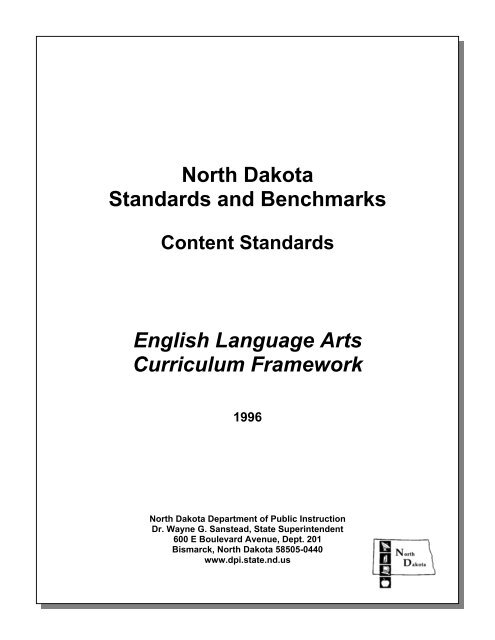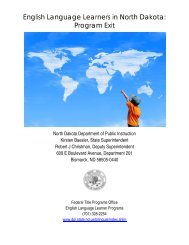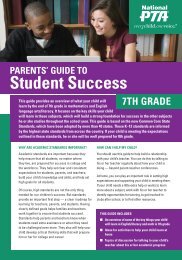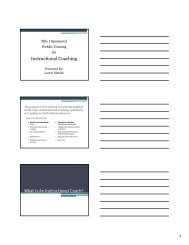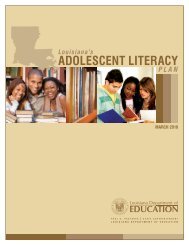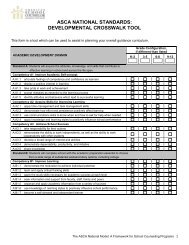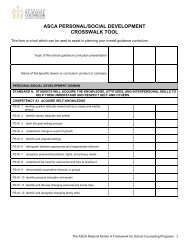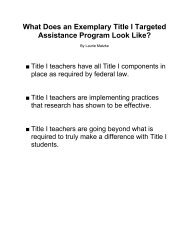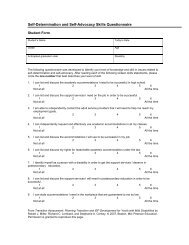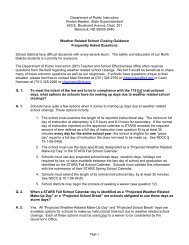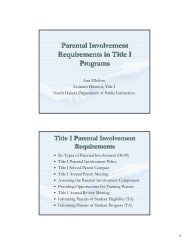North Dakota Standards and Benchmarks English Language Arts ...
North Dakota Standards and Benchmarks English Language Arts ...
North Dakota Standards and Benchmarks English Language Arts ...
Create successful ePaper yourself
Turn your PDF publications into a flip-book with our unique Google optimized e-Paper software.
<strong>North</strong> <strong>Dakota</strong><strong>St<strong>and</strong>ards</strong> <strong>and</strong> <strong>Benchmarks</strong>Content <strong>St<strong>and</strong>ards</strong><strong>English</strong> <strong>Language</strong> <strong>Arts</strong>Curriculum Framework1996<strong>North</strong> <strong>Dakota</strong> Department of Public InstructionDr. Wayne G. Sanstead, State Superintendent600 E Boulevard Avenue, Dept. 201Bismarck, <strong>North</strong> <strong>Dakota</strong> 58505-0440www.dpi.state.nd.us
Permission to reproduce this material is granted for home, classroom, <strong>and</strong> workshopuse. For all other purposes, please request permission in writing from the <strong>North</strong> <strong>Dakota</strong>Department of Public Instruction.This project was made possible through the U.S. Department of Education Secretary’sFund of Innovation, Award #R215G30039, <strong>and</strong> U.S. Department of Education Title IProgram Improvement Grant, CFDA 84.218A.No person shall, on the basis of race, sex, color, national origin, religion, age orh<strong>and</strong>icapping condition, be excluded from participation in, be denied the benefits of, orbe subjected to discrimination under any program or activity receiving federal financialassistance.
ND Project DirectorClarence A. Bina, PhDDirector of Special Projects<strong>North</strong> <strong>Dakota</strong> Department of PublicInstruction600 East Boulevard Avenue-9th FloorBismarck, <strong>North</strong> <strong>Dakota</strong> 58505-0440(701) 328-2098 FAX (701) 328-4770cbina@mail.state.nd.usProject AssistantJolli MarcellaisMcREL ConsultantsTom Barlow, 1996Ceri B. Dean, 1996Diane E. Paynter, 1994Joan B. Grady, 19942550 S Parker Road, Suite 500Aurora, Colorado 80014(303) 337-0990 FAX (303)337-3005ProductionJeanne DeakAmy Garcia
Table of ContentsPrefaceBasic AssumptionsDefinitionsPurpose<strong>North</strong> <strong>Dakota</strong> <strong>English</strong> <strong>Language</strong> <strong>Arts</strong> Content <strong>St<strong>and</strong>ards</strong><strong>North</strong> <strong>Dakota</strong> <strong>English</strong> <strong>Language</strong> <strong>Arts</strong> Content <strong>St<strong>and</strong>ards</strong> <strong>and</strong> BenchmarkSummary of <strong>St<strong>and</strong>ards</strong> <strong>and</strong> <strong>Benchmarks</strong><strong>North</strong> <strong>Dakota</strong> <strong>English</strong> <strong>Language</strong> <strong>Arts</strong> CommitteeHistory of the <strong>North</strong> <strong>Dakota</strong> <strong>English</strong> <strong>Language</strong> <strong>Arts</strong> ProjectAppendix ASelected List of works Consulted
PrefaceThe <strong>North</strong> <strong>Dakota</strong> Collaborative Project for the Improvement of <strong>English</strong> Education is athree-year project funded by a grant from the U.S. Department of Education. The projectgoal is to improve student achievement in the <strong>English</strong> language arts by engagingstudents in challenging literacy st<strong>and</strong>ards. The three components of the project includethe (1) development of <strong>English</strong> language arts content st<strong>and</strong>ards; (2) piloting of a staffdevelopment model; <strong>and</strong> (3) development of model guidelines for teacher preparationprograms <strong>and</strong> teacher certification/recertification st<strong>and</strong>ards. This document addressesPart 1 of the grant content st<strong>and</strong>ards <strong>and</strong> benchmarks for the <strong>English</strong> <strong>Language</strong> <strong>Arts</strong>.The original Curriculum Framework Writing Committee (1994) <strong>and</strong> the RevisionCommittee (1996) represent a broad range of elementary, middle <strong>and</strong> secondaryteachers: rural/urban, public/nonpublic, small/large, Native American, <strong>and</strong> Title 1. Thesecommittees spent many hours gaining background knowledge in the nature <strong>and</strong>character of content st<strong>and</strong>ards, <strong>and</strong> these committees built consensus <strong>and</strong> reachedagreement as to what students should know about <strong>and</strong> do with st<strong>and</strong>ard American<strong>English</strong>. The consensus was derived from (1) current research; (2) the draft st<strong>and</strong>ards ofthe National Council of Teachers of <strong>English</strong> <strong>and</strong> the International Reading Association;(3) the <strong>North</strong> <strong>Dakota</strong> Curriculum Frameworks: Volume 1 (1993); (4) field testing the<strong>North</strong> <strong>Dakota</strong> <strong>English</strong> <strong>Language</strong> <strong>Arts</strong> Curriculum Framework: <strong>St<strong>and</strong>ards</strong> <strong>and</strong><strong>Benchmarks</strong> (1994) <strong>and</strong> (5) the comments received from a statewide call for revision tothe documents.The writers of this revised edition of the <strong>North</strong> <strong>Dakota</strong> <strong>English</strong> <strong>Language</strong> <strong>Arts</strong> CurriculumFrame: <strong>St<strong>and</strong>ards</strong> <strong>and</strong> Benchmark (1996) were guided, as was the original writingcommittee, by a set of principles which would produce a st<strong>and</strong>ards document that (1)states “big ideas” (content), (2) is benchmarked, (3) is limited to a teachable/learnablenumber of st<strong>and</strong>ards, (4) is easy to use, (5) is relevant to today’s world, <strong>and</strong> (6) is linkedto performance requirements in <strong>North</strong> <strong>Dakota</strong> Schools.As stated in the first edition, the <strong>North</strong> <strong>Dakota</strong> <strong>Language</strong> <strong>Arts</strong> Committee believes thatthe <strong>North</strong> <strong>Dakota</strong> <strong>English</strong> <strong>Language</strong> <strong>Arts</strong> content st<strong>and</strong>ards will help prepare <strong>North</strong><strong>Dakota</strong> students for the evolving complexities of work <strong>and</strong> social life.The committee members continue to receive from their colleagues <strong>and</strong> administratorsmany positive comments regarding the document. Further, the leadership of the <strong>North</strong><strong>Dakota</strong> Council of Teachers of <strong>English</strong>, the <strong>North</strong> <strong>Dakota</strong> Reading Association, the <strong>North</strong><strong>Dakota</strong> Speech <strong>and</strong> Theater Association, <strong>and</strong> the <strong>North</strong> <strong>Dakota</strong> Association forEducation of Young Children provided critical support <strong>and</strong> advocacy for the project.The committee chose the format of this document with the hope that <strong>North</strong> <strong>Dakota</strong>parents, teachers, <strong>and</strong> education leaders will find it useful in the education of <strong>North</strong><strong>Dakota</strong>’s youth.Clarence A. Bina, Project Director
Basic Assumptions1. The st<strong>and</strong>ards that are identified represent literacy st<strong>and</strong>ards – the fundamentalknowledge <strong>and</strong> skills that all educated, literate people should have <strong>and</strong> be able touse..2. The st<strong>and</strong>ards are content st<strong>and</strong>ards identifying what students should underst<strong>and</strong><strong>and</strong> be able to do in <strong>English</strong> <strong>Language</strong> <strong>Arts</strong>.3. The <strong>North</strong> <strong>Dakota</strong> Curriculum Frameworks: Volume I (1993) identifies as one of sixgraduation outcomes for students the use of complex reasoning processes. This1996 st<strong>and</strong>ards <strong>and</strong> benchmarks document is guided by the assumption thatcomplex reasoning st<strong>and</strong>ards, which permeate al disciplines, will be determined atthe local level.4. <strong>Benchmarks</strong> are identified for each st<strong>and</strong>ard <strong>and</strong> represent development levels atthe 4 th , 8 th , <strong>and</strong> 12 th grades.5. The st<strong>and</strong>ards <strong>and</strong> benchmarks are followed by examples of specific knowledge <strong>and</strong>performance activities that support them. That is, these examples are meant to besuggested illustrations to help teachers in their underst<strong>and</strong>ing of the st<strong>and</strong>ards <strong>and</strong>benchmarks. THESE ACTIVITIES ARE NOT MANDATES.6. Classroom implementation should reflect not only the content of st<strong>and</strong>ards <strong>and</strong>benchmarks but also the best instructional practices <strong>and</strong> research.7. The st<strong>and</strong>ards <strong>and</strong> benchmarks are designated by numbers. This does not assume ascope or sequence, but rather the number is for ease in referencing this document.
DefinitionsCurriculum FrameworkState curriculum frameworks serve as a bridge between the content st<strong>and</strong>ards <strong>and</strong> theclassroom by providing for the content of the curriculum <strong>and</strong> how that content should beorganized <strong>and</strong> presented.St<strong>and</strong>ardA description of what students should know <strong>and</strong> be able to do. Literacy St<strong>and</strong>ardThe fundamental knowledge <strong>and</strong> skills that all educated, literate people should have <strong>and</strong>be able to use.Content St<strong>and</strong>ardA description of what students should know <strong>and</strong> be able to do within a particulardiscipline or content domain.BenchmarkA translation of a st<strong>and</strong>ard into what the students should underst<strong>and</strong> <strong>and</strong> be able to doat developmentally appropriate levels (grades 4,8, <strong>and</strong> 12).Performance ActivityAn activity that allows students to demonstrate knowledge of the st<strong>and</strong>ard.
PurposeThe writers of this document feel it is important to emphasize three points:1. These st<strong>and</strong>ards are designed to be a framework to assist teachers <strong>and</strong> schooldistricts when planning language curriculum. We hope this document will be used asa general guideline in the <strong>English</strong> language arts classroom <strong>and</strong> will be extended bythe teacher through innovation <strong>and</strong> creativity.2. For purposes of discussion <strong>and</strong> assessment, we have designed various distinctst<strong>and</strong>ards within the language arts curriculum. We assume that reading, writing,speaking, <strong>and</strong> listening will be integrated in all classrooms.3. We recognize that many <strong>North</strong> <strong>Dakota</strong> <strong>English</strong> <strong>Language</strong> <strong>Arts</strong> teachers are alreadyteaching toward these st<strong>and</strong>ards <strong>and</strong> benchmarks.<strong>English</strong> language arts-reading, writing, speaking, <strong>and</strong> listening-is fundamental inconstructing knowledge in all academic disciplines, succeeding in the world of work, <strong>and</strong>making sense of everyday life. With the help of innovative <strong>and</strong> creative teachers, thesest<strong>and</strong>ards can help students adapt to the continually changing world of communication.The Revision Committee
<strong>North</strong> <strong>Dakota</strong> <strong>English</strong> <strong>Language</strong> <strong>Arts</strong>Content <strong>St<strong>and</strong>ards</strong>St<strong>and</strong>ard 1: Students gather <strong>and</strong> organize information.St<strong>and</strong>ard 2: Students engage in the reading process.St<strong>and</strong>ard 3: Students comprehend literature.St<strong>and</strong>ard 4: Students engage in the writing process.St<strong>and</strong>ard 5: Students write for a variety of purposes <strong>and</strong> audiences.St<strong>and</strong>ard 6: Students engage in speaking <strong>and</strong> listening processes.St<strong>and</strong>ard 7: Students underst<strong>and</strong> <strong>and</strong> use principles of language.
St<strong>and</strong>ard 1Students gather <strong>and</strong> organize information.Benchmark 41.4.1 Underst<strong>and</strong> main idea <strong>and</strong> supporting details1.4.2 Use simple organizational strategies1.4.3 Use appropriate reference tools1.4.4 Use vocabulary knowledge to gather information.Benchmark 81.8.1 Provide accurate summaries using story elements.1.8.2 Use context clues to determine meaning1.8.3 Use a variety of organizational strategies1.8.4 Use appropriate reference tools <strong>and</strong> available technology to support learning1.8.5 Use new vocabulary from reading <strong>and</strong> listeningBenchmark 121.12.1 Analyze information for relevance, reliability, <strong>and</strong> validity1.12.2 Use complex structures to organize <strong>and</strong> analyze information1.12.3 Use cross-referencing while gathering information
St<strong>and</strong>ard 1Students gather <strong>and</strong> organize information.Benchmark 41.4.1 Underst<strong>and</strong> main idea <strong>and</strong> supporting details1.4.2 Use simple organizational strategies1.4.3 Use appropriate reference tools1.4.4 Use vocabulary knowledge to gather informationExamples of specific knowledge that support the st<strong>and</strong>ard <strong>and</strong> benchmarks• Main idea, supporting details• Sequence patterns, lists, problem/solution patterns, story maps, introduction, body,beginning/middle/end, conclusions, story frames.• Technology, glossary, dictionary, globe, encyclopedia, thesaurus, atlas, magazine, cardcatalogue, table of contents, alphabetical order, guide words, charts, graphics• Root word, prefixes, suffixes, compound words, multiple meanings, key words, antonyms,synonymsExamples of performance activities that support the st<strong>and</strong>ard <strong>and</strong> benchmarks• ACTIVITY #1Have students use a variety of reference tools to research the history of a particularera. Using information gathered from the various reference materials, create a time linedepicting the main events.• ACTIVITY #2Have students identify <strong>and</strong> interview individuals in the community. Have students reportto the class the information they gathered from their interviews.• ACTIVITY #3Have students gather information about an animal they would like to know more about.Have them organize information about size, food, habitat, etc. using a model, graph orchart.
St<strong>and</strong>ard 1Students gather <strong>and</strong> organize information.Benchmark 81.8.1 Provide accurate summaries using story elements1.8.2 Use context clues to determine meaning1.8.3 Use a variety of organizational strategies1.8.4 Use appropriate reference tools <strong>and</strong> available technology to support learning1.8.5 Use new vocabulary from reading <strong>and</strong> listeningExamples of specific knowledge that support the st<strong>and</strong>ard <strong>and</strong> benchmarks• Summarizing, main character, supporting characteristics, mood, tone, internal/externalconflict, foreshadowing, turning point, suspense, subplots, climax• Denotation, connotation, st<strong>and</strong>ard/non-st<strong>and</strong>ard <strong>English</strong>, inferential meaning, dialect,homophones, homographs• Cause/effect patterns, Venn Diagrams*, time lines, generalization patterns, outline forms,t-notes, paraphrasing, flash cards, study charts, flow charts, note-taking• Dictionaries, CD ROM’s graphic aids, laser discs, Reader’s Guide, Dewey DecimalSystem• Word clusters, multiple meaningsExamples of performance activities that support the st<strong>and</strong>ard benchmarks• ACTIVITY #1In small groups, have students summarize a particular novel using the story elements asthe basis of their summaries. Then have students compare <strong>and</strong> contrast the storyelements of that novel with a movie version of the same, using a Venn Diagram to depictthe similarities <strong>and</strong> differences.• ACTIVITY #2Have students determine a topic on which they would like to write. Have them gatherbackground knowledge using a variety of reference materials. As a class, record thevarious reference materials used <strong>and</strong> have students classify them according to specificcriteria decided upon by the class. Record what students learned abut referencematerials as a result of their classifying.• ACTIVITY #3Using a novel they are presently reading, have students identify three unfamiliar wordsthey have encountered. Working with a partner, have them identify any phrases or wordssurrounding the unknown words that would give them a clue as to what the unknownwords mean. Have them make guesses as to what the words mean <strong>and</strong> confirm ordisconfirm their guesses through the use of a dictionary, glossary, thesaurus or expert. Insmall groups have students share which context clues were most useful in trying to figureout the meaning of the words <strong>and</strong> why they were most useful.• ACTIVITY #4Model for students several graphic organizers that could be used for pre-writing, such asmapping, clustering, <strong>and</strong> listing. Have students select one <strong>and</strong> use it as they prepare towrite a story. When they have completed their first draft, have them verbalize in smallgroups how their graphic organizer affected their writing.*Venn Diagram-A pictorial way of representing relationships between sets.
St<strong>and</strong>ard 1Students gather <strong>and</strong> organize information.Benchmark 121.12.1 Analyze information for relevance, reliability, <strong>and</strong> validity1.12.2 Use complex structures to organize <strong>and</strong> analyze information1.12.3 Use cross-referencing while gathering informationExamples of specific knowledge that support the st<strong>and</strong>ard <strong>and</strong> benchmarks• Clarity, relevance, thesis, <strong>and</strong> supporting material• Internal summaries, transitions, hierarchical relationships, precis, thesis statements, treediagrams, cluster maps• Library reference materials, authoritative sources, surveys, triangulation of sourcesExamples of performance activities that support the st<strong>and</strong>ard <strong>and</strong> benchmarks• ACTIVITY #1Having completed reading a persuasive essay, have students organize the essayshowing the hierarchical relationship of the arguments along with their support. Thenhave them select the two strongest arguments <strong>and</strong> orally counter-argue them. Have themshare with the class the organizing structure they used for their counter arguments.• ACTIVITY #2Have students convince their peers in an oral presentation that an authoritative sourcethey wish to use for a research paper is an expert. Have students provide support theirposition.• ACTIVITY #3Have students prepare a research paper, keeping a record of the sources they are using.Have students create a graphic organizer to depict any cross referencing they haveengaged in while preparing their paper that helps validate the information they are using.In small groups, have students share how cross referencing their sources affected theirresearch paper.
St<strong>and</strong>ard 2Students engage in the reading process.Benchmark 42.4.1 Use strategies for activating prior knowledge to comprehend text2.4.2 Make <strong>and</strong> confirm predictions to enhance underst<strong>and</strong>ing2.4.3 Determine a specific purpose for reading2.4.4 Seek help to underst<strong>and</strong> information2.4.5 Use a variety of clues to determine the meaning of words2.4.6 Use mental pictures to help increase underst<strong>and</strong>ingBenchmark 82.8.1 Read a variety of materials2.8.2 Organize prior knowledge of a topic before reading2.8.3 Make <strong>and</strong> confirm/disconfirm complex predictions to increase underst<strong>and</strong>ing2.8.4 Independently set a purpose for reading2.8.5 Use strategies for clarificationBenchmark 122.12.1 Construct meaning while reading <strong>and</strong> adjust for underst<strong>and</strong>ing2.12.2 Read a variety of textsReflect on what has been learned from reading <strong>and</strong> recognize underlying meaning
St<strong>and</strong>ard 2Students engage in the reading process.Benchmark 42.4.1 Use strategies for activating prior knowledge to comprehend text2.4.2 Make <strong>and</strong> confirm predictions to enhance underst<strong>and</strong>ing2.4.3 Determine a specific purpose for reading2.4.4 Seek help to underst<strong>and</strong> information2.4.5 Use a variety of clues to determine the meaning of words2.4.6 Use mental pictures to help increase underst<strong>and</strong>ingExamples of specific knowledge that support the st<strong>and</strong>ard <strong>and</strong> benchmarks• Brainstorming, clustering, activating prior knowledge, semantic mapping, KWL (SeeActivity 4 below)• Predicting before reading, setting a purpose, previewing a text, skimming, selecting abook• Questioning before, during <strong>and</strong> after reading; then confirming, disconfirming• Conferencing, learning logs, self-monitoring, discussions, retelling, assisted reading,paired reading, collaborative learning• Context clues, illustrations, root words, affixes• Poetic images, figurative languagesExamples of performance activities that support the st<strong>and</strong>ard <strong>and</strong> benchmarks• ACTIVITY #1At the beginning of a language arts unit, construct a KWL chart with students. Have themidentify what they already Know (K) about the particular topic of the unit <strong>and</strong> what theyWould like (W) to know. Use this information to help make decisions as to what will betaught in the unit. At the conclusion of the unit, have students give responses as to whatthey have Learned (L). They may even lead to a discussion about questions they stillhave about the topic.• ACTIVITY #2Before students read a book they have selected, have them share in small groups whythey selected their book. Have them predict for their group what their story might beabout <strong>and</strong> record their predictions. After reading their books, have students return to theirsmall groups <strong>and</strong> determine the extent to which their stories actually matched theirpredictions. Have each small group report to the entire class as to how predicting helpedthem prepare for reading.• ACTIVITY #3Have students select a partner <strong>and</strong> choose a book they can read out loud to each other.After they read, have partners discuss part of the story to clarify meaning.• ACTIVITY #4Select a book that would be appropriate to read aloud to students. Model for them how toperuse the book in order to get a sense of what the book is about. As a class, determinewhat questions students might have as a result of perusing the book. Record thesequestions on a chart <strong>and</strong> monitor whether or not the questions are answered as studentsread the book. Allow students to add any new questions to the chart that arise during thereading of the book.
St<strong>and</strong>ard 2Students engage in the reading process.Benchmark 82.8.1 Read a variety of materials2.8.2 Organize prior knowledge of a topic before reading2.8.3 Make <strong>and</strong> confirm/disconfirm complex predictions to increase underst<strong>and</strong>ing2.8.4 Independently set a purpose for reading2.8.5 Generate questions while reading2.8.6 Use strategies for clarificationExamples of specific knowledge that support the st<strong>and</strong>ard <strong>and</strong> benchmarks• Story maps, beginning/middle/end, brainstorming, story frames, graphic organizers,outline forms• Predicting, confirming, disconfirming• Reading strategies (e.g., SQRRR* strategy, reciprocal teaching, QAR** strategy, usingwho, what, when <strong>and</strong> where)• Paraphrasing, highlighting, debating• Reading rate, re-reading, reading on, ab<strong>and</strong>oning, skimming, skippingExamples of performance activities that support the st<strong>and</strong>ard <strong>and</strong> benchmarks• ACTIVITY #1Before students read their mystery stores, have them peruse the book they have selectedto get a sense of what their mystery might be about. Ask them to depict what they alreadyknow about mysteries through the use of a graphic organizer. As they read their mystery,have them revisit their graphic organizer several times <strong>and</strong> change or refine it to depicttheir changing knowledge. In small groups, have them share how prior knowledge aidedthem in their comprehension.• ACTIVITY #2As students read a particular book, have them keep a journal of the questions that cometo their minds before they begin reading, while they are reading, <strong>and</strong> after they havecompleted reading. Have them share with a partner how these questions made adifference in their reading.• ACTIVITY #3In small groups, introduce a difficult reading passage. Have students create a posterwhich depicts strategies that they use to help them clear up confusion while they arereading.• ACTIVITY #4Have students select a partner <strong>and</strong> choose a book that they will read together. As themto use a combination of methods for reading the book, such as reading aloud to eachother <strong>and</strong> reading silently. Have them monitor their comprehension along the way bytaking turns summarizing what they each have read. Encourage them to haveconversations as to which parts were confusing to them. As a class, discuss howsummarizing affects their comprehension.• ACTIVITY #5Have students read the instruction manual for programming a VCR. Then paraphrase theinstructions to a partner.*SQRRR strategy-Survey, Questions, Read, Recite, Review**QAR strategy-Question, Answer, Relationship
St<strong>and</strong>ard 2Students engage in the reading process.Benchmark 122.12.1 Construct meaning while reading <strong>and</strong> adjust for underst<strong>and</strong>ing2.12.2 Read a variety of texts2.12.3 Questions text2.12.4 Reflect on what has been learned from reading <strong>and</strong> recognize underlying meaningExamples of specific knowledge that support the st<strong>and</strong>ard <strong>and</strong> benchmarks• Prior knowledge, reading strategies (e.g., KWL, QAR, SQRRR, reciprocal teaching)• Propag<strong>and</strong>a, poetic license, bias, fallacies, redundancy, triangulation of sources, evasionof issues, false analogies, misused evidence, ambiguity, manipulative language, jargon,cliches• Think aloud, learning journals, conversations, conferencesExamples of performance activities that support the st<strong>and</strong>ard <strong>and</strong> benchmarks• ACTIVITY #1While reading a passage, have students consciously engage their senses of sight, sound,<strong>and</strong> smell to generate mental pictures while reading. Have them share in small groupshow this affected their ability to make sense of the text. Over a period of time, have themcontinue to practice this, recording their thoughts <strong>and</strong> experiences in a journal.• ACTIVITY #2Have students find examples of advertisements in newspapers or magazines whichcontain propag<strong>and</strong>a, faulty reasoning, misused evidence, or cliches. Using theseexamples, have students create a survey to gather information as to how other studentsview the information <strong>and</strong> the overall effect the information has on them as consumers.Have students write a letter to the editor of the magazine or newspaper explaining whythey are for or against the use of these elements in advertising <strong>and</strong> why the paper ormagazine should or should not allow these advertising strategies. The letter shouldinclude evidence collected from the survey. Have students share their letters as well astheir pre-writing strategies.• ACTIVITY #3Have students construct a paper that identifies the underlying theme(s) in a soliloquy orfamous speech from one of Shakespeare’s works <strong>and</strong> tell how the theme(s) follow thesame general pattern as a modern soliloquy or famous speech.• ACTIVITY #4Have students read <strong>and</strong> follow directions for a home improvement project. Thenprepare a multimedia presentation for the class.
St<strong>and</strong>ard 3Students comprehend literature.Benchmark 43.4.1. Make connections between personal experiences <strong>and</strong> specific incidents in a text3.4.2. Make connections among works of literature3.4.4. Underst<strong>and</strong> the characteristics of various simple genresBenchmark 83.8.1 Underst<strong>and</strong> that events <strong>and</strong> themes in literature parallel <strong>and</strong> often impact events in theirlives3.8.2 Use specific aspects of literature to better underst<strong>and</strong> their own <strong>and</strong>/or others’ thoughts<strong>and</strong> actions3.8.3 Underst<strong>and</strong> that a single text may elicit a wide variety of responses3.8.4 Underst<strong>and</strong> the characteristics of a wide variety of genresBenchmark 123.12.1 Analyze how literature reflects its culture <strong>and</strong> historical period3.12.2 Underst<strong>and</strong> that the reader interacts with the textUnderst<strong>and</strong> how genre characteristics affect a given text
St<strong>and</strong>ard 3Students comprehend literature.Benchmark 43.4.1 Make connections between personal experiences <strong>and</strong> specific incidents in a text3.4.2 Underst<strong>and</strong> the story elements3.4.3 Make connections among works of literature3.4.4 Underst<strong>and</strong> the characteristics of various simple genresExamples of specific knowledge that support the st<strong>and</strong>ard <strong>and</strong> benchmarks• Personal experience, prior knowledge, themes in literature• Character, setting, conflict, plot, theme• Caldecott <strong>and</strong> Newbery books, author studies, genre, diverse cultures• Fiction, non-fiction, fantasy, fairy tales, poetry, plays, fables, folktales, rebus stories,wordless books, predictable books, counting books, animal stories.Examples of performance activities that support the st<strong>and</strong>ard <strong>and</strong> benchmarks• ACTIVITY #1While reading a book, have students select passages from the book which remind themof, or have a special relationship to, something from their own lives. Have them drawpictures depicting these events <strong>and</strong> share them in a small group. Then, as a class, recordstudent responses as to why they think that connecting personal experiences to whatthey are reading might be important in helping them become more effective readers.• ACTIVITY #2Have students choose <strong>and</strong> dress as their favorite character from a book they have justread. Have them given an oral report that includes a description of the setting of thestory, the basic plot involved <strong>and</strong> any themes they recognized while reading. Whenstudents have completed their oral reports, have them choose a partner <strong>and</strong> compare<strong>and</strong> contrast the setting, plot, <strong>and</strong> themes in their stories.• ACTIVITY #3Having read aloud a story to students, have them share with the class which part of thestory reminded them of an experience. Encourage students to have a conversation as tohow they think authors get ideas for their stories.• ACTIVITY #4Provide students with a variety of books written by the same author. Have them selectone of the books to read. After the students have completed their reading, ask them toform groups of three (each of them having read a different book) <strong>and</strong> try to determinecharacteristics that might be similar in all of the books. Have them come to someconclusions about the author based on these similar characteristics. Record each group’sconclusions on a chart.• ACTIVITY #5Present students with an example of a tall tale, pointing out that tall tales all have similarcharacteristics. After discussing these characteristics, have students individually write atall tale, which contains the characteristics identified. In small groups, have them defendwhy their story would be considered a tall tale.
St<strong>and</strong>ard 3Students comprehend literature.Benchmark 83.8.1 Underst<strong>and</strong> that events <strong>and</strong> themes in literature parallel <strong>and</strong> often impact events in theirlives3.8.2 Use specific aspects of literature to better underst<strong>and</strong> their own <strong>and</strong>/or others’ thoughts<strong>and</strong> actions3.8.3 Underst<strong>and</strong> that a single text may elicit a wide variety of responses3.8.4 Underst<strong>and</strong> the characteristics of a wide variety of genresExamples of specific knowledge that support the st<strong>and</strong>ard <strong>and</strong> benchmarks• Repetition of patterns in literature <strong>and</strong> in life (e.g., coming of age, rites of passage, birth,spring)• Point of view, satire, irony, rising action, theme, resolution, plot, author’s meaning, mood,tone• Diversity of response• Short stories, mysteries, poetry, drama, legends, biographies, autobiographies, historicalfiction, science fiction, adventure myths, informational articles.Examples of performance activities that support the st<strong>and</strong>ard <strong>and</strong> benchmarks• ACTIVITY #1Have students keep a double-entry diary while reading. Have them identify on the leftside of the page passages within their reading that are meaningful to them. Have themshare their responses with a partner. As a class, discuss how relating the text to theirown lives influences their underst<strong>and</strong>ing of what is happening in the story.• ACTIVITY #2Have students compare <strong>and</strong> contrast one author’s use of irony with another author’s use.In small groups, have them share what they learned as a result of their comparisons.• ACTIVITY #3As students read a selected text, have them keep journal entries that depict theirresponses to the text. Working with a partner, have them state their reactions to specificsections, explaining to the partner why they had that reaction. Then have the partnershare his/her reaction to the same section. As a whole class, discuss why a single textmight elicit a wide variety of responses.• ACTIVITY #4After having read a science fiction story, have students, as a class, predict what theythink the “jobs of the future” might be. Have them use information from their sciencefiction story to support their predictions.
St<strong>and</strong>ard 3Students comprehend literature.Benchmark 123.12.1 Analyze how literature reflects its culture <strong>and</strong> historical period3.12.2 Underst<strong>and</strong> that the reader interacts with the text3.12.3 Underst<strong>and</strong> how genre characteristics affect a given textExamples of specific knowledge that support the st<strong>and</strong>ard <strong>and</strong> benchmarks• Classical through modern literature, early manuscripts, oral tradition, language evolution,etymology• Universal symbolic themes, the variety of human experience• Anecdotes, essays, poetry, screenplays, tragedies, speeches, folktales, satire, debate,monologue, blank verse, sonnets, improvisation, dramaExamples of performance activities that support the st<strong>and</strong>ard <strong>and</strong> benchmarks• ACTIVITY #1Have students select a version (written or oral) of a legend from a specific culture. In anoral presentation, have them present how the legend was influenced by the life <strong>and</strong>culture of the people at that time <strong>and</strong> how, over time, those influences have changed.• ACTIVITY #2Have students keep a journal while reading a specific text. The journal should include notonly their acknowledgement of background knowledge <strong>and</strong> experience that they asreaders bring to the text, but also an acknowledgement of their thoughts, feelings, <strong>and</strong>interactions with the text. Have them compare <strong>and</strong> contrast their experiences with aclassmate.• ACTIVITY #3Have students watch several examples of monologue presented from radio <strong>and</strong>/ortelevision. From these examples, ask students to determine what characteristics need tobe present for a monologue to have an overall positive effect on viewers. Using thesecharacteristics, have students write <strong>and</strong> present personal monologues to theirclassmates. Allow students to discuss how the presence of absence of the characteristicseither positively or negatively affected the presentation.• ACTIVITY #4Have students read an autobiography or biography of an American inventor. Then havethe students write an analytical paper showing how an invention or improvement upon aprocess changed the nature of work (necessary work skills), changed the workingenvironment, or changed society itself
St<strong>and</strong>ard 4Students engage in the writing process.Benchmark 44.4.1 Use knowledge <strong>and</strong> experience to write4.4.2 Use planning to organize thoughts before writing4.4.3 Use editing skills to improve reader comprehensionBenchmark 84.8.1 Identify a topic <strong>and</strong> determine its development4.8.2 Use multiple drafts, when appropriate, to clarify language <strong>and</strong> intent4.8.3 Use feedback to revise4.8.4 Edit to improve comprehensionBenchmark 124.12.1 Plan, write, <strong>and</strong> revise4.12.2 Use st<strong>and</strong>ard conventions of grammar, punctuation, <strong>and</strong> spelling appropriate to theselected audience4.12.3 Identify personal strengths <strong>and</strong> weaknesses in writing <strong>and</strong> seek feedback from others toimprove writing
St<strong>and</strong>ard 4Students engage in the writing process.Benchmark 44.4.1 Use knowledge <strong>and</strong> experience to write4.4.2 Use planning to organize thoughts before writing4.4.3 Use editing skills to improve reader comprehensionExamples of specific knowledge that support the st<strong>and</strong>ard <strong>and</strong> benchmarks• Personal experience, background knowledge, selecting a topic, interviewing, gatheringinformation, observing, building background, interest inventory, journal writing• Brainstorming, webbing, listing, sequencing, dialogue, taking notes, outlining, graphicorganizers• Reflecting, conferencing, peer revising, peer-editing, audience feedback, exp<strong>and</strong>ing orcombining sentences, connecting paragraphs, direct objects, action verbs, spelling rules(e.g., words with ei or ie, adding suffixes, irregular verbs, final y to i), capital letters,commas, periods, exclamation marks.• Apostrophes, quotation marks, proofreading marks, h<strong>and</strong>writing, spacing, alignments,paper <strong>and</strong> pencil position.Examples of performance activities that support the st<strong>and</strong>ard <strong>and</strong> benchmarks• ACTIVITY 1Have students select a partner to discuss various experiences they have had in their liveswhich were memorable or interesting. Encourage the partners to also discuss hobbiesthey might have or interests outside of school. Have students keep a record of the topicsthey discussed <strong>and</strong> help them see that these may be events or stories about which theymight like to write.• ACTIVITY #2After demonstrating several proofreading marks, have students select a partner to peeredit a piece of writing. Have them work together to identify incorrect spellings orpunctuation marks <strong>and</strong> markings which would be appropriate.• ACTIVITY #3As students are involved in the writing process, model a pre-writing organizational toolsuch as webbing. Have students use the tool as they begin to plan for their new piece ofwriting <strong>and</strong>, in small groups, share the tool <strong>and</strong> discuss how it helped them in theirwriting.• ACTIVITY #4After students have completed a first draft of their writing, have them select a partner toread their draft. Allow the partner to ask any questions regarding the story to clarify whatthe story is about or to give any feedback as to what might make the story more effective.Have the author use this information to make any necessary changes to the draft. Insmall groups have students discuss how peer revising affected their stories.
St<strong>and</strong>ard 4Students engage in the writing process.Benchmark 84.8.1 Identify a topic <strong>and</strong> determine its development4.8.2 Use multiple drafts, when appropriate, to clarify language <strong>and</strong> intent4.8.3 Use feedback to revise4.8.4 Edit to improve comprehensionExamples of specific knowledge that support the st<strong>and</strong>ard <strong>and</strong> benchmarks• Pre-writing strategies, structure <strong>and</strong> development of paragraphs, unity, clarity, balance,leads, dialogue, originality, vitality, voice, tone, tense• Conferencing, rough draft, final draft, post-writing, using checklists• Peer conferencing, audience feedback, revision techniques (e.g., writing on every otherline, revision buddies)• Exact words, descriptive detail, elaboration, worn-out words, phrases <strong>and</strong> clauses,misplaced modifiers, compound/complex sentences, inverted sentences, run-ons,hyphens, dashes, parentheses, spelling rules, computer spell checksExamples of performance activities that support the st<strong>and</strong>ard <strong>and</strong> benchmarks• ACTIVITY #1Have students select an experience about which they would like to write. As a pre-writingstrategy, have them brainstorm their topics using a clustering or webbing technique.• ACTIVITY #2During the revision stage of the writing process, have students underline overused orworn-out words in their pieces of writing. Have them replace these words with ones thatare more descriptive or meaningful. In small groups, l have students discuss how thisstrategy might make their writing more interesting or meaningful.• ACTIVITY #3Model for students an editing strategy using a piece of writing that is ready for editing.Cover the piece of writing with a sheet of paper. Move the paper down the story,exposing each line. Line by line, read each sentence backwards <strong>and</strong> forward to identifyany errors in spelling. Have students use a dictionary or the thesaurus for words aboutwhich they are unsure. Encourage students to use this strategy for editing their ownstories.• ACTIVITY #4Students choose a vocation based on the results of an interest inventory (check withguidance). Research chosen vocation, using a variety of sources. Write a paper on theoccupation <strong>and</strong> present to the class.
St<strong>and</strong>ard 4Students engage in the writing process.Benchmark 124.12.1 Plan, write <strong>and</strong> revise4.12.2 Use st<strong>and</strong>ard conventions of grammar, punctuation, <strong>and</strong> spelling appropriate to theselected audience4.12.3 Identify personal strengths <strong>and</strong> weaknesses in writing <strong>and</strong> seek feedback from others toimprove writingExamples of specific knowledge that support the st<strong>and</strong>ard <strong>and</strong> benchmarks• Coherence, sensory details, pre-writing strategies, vivid language, unity, clarity• Fragments used with a purpose, run-on sentences, parallel structures, sentencereduction, elliptical clauses, coordinating conjunctions, transitional devices, clausal <strong>and</strong>phrasal patterns, semi-colons, colons to introduce lists, hyphens, ellipses, quotes within aquote, verb tense, alternative spellings, irregular spellings, proofreading• Self-monitoring, conferencing, holistic evaluationExamples of performance activities that support the st<strong>and</strong>ard <strong>and</strong> benchmarks• ACTIVITY #1Have students select an experience about which they would like to write, <strong>and</strong> have themwrite to the point of being ready to edit their pieces. Using a checklist, have them edittheir work. Having completed their self-editing, students engage in a conversation withthe teacher, noting strengths <strong>and</strong> weaknesses of the self-editing experience.• ACTIVITY #2Have students document sources, anecdotes, statistics, <strong>and</strong> quotations in a researchpaper according to MLA guidelines.• ACTIVITY #3As students submit their final draft of a piece they have written, have them prepare <strong>and</strong>attach a self-evaluation of their writing that includes new insights they have gained whilewriting, strategies that have had a positive effect on their piece, <strong>and</strong> strengths of the finaldraft.• ACTIVITY #4Have students compare a finished piece of writing from several months ago to a presentpiece of writing. Have them identify areas in which they have achieved growth, <strong>and</strong> havethem establish goals for future writing experiences.
St<strong>and</strong>ard 5Students write for a variety of purposes <strong>and</strong> audiences.Benchmark 45.4.1 Write for a different audiences5.4.2 Underst<strong>and</strong> that different purposes require different forms of writing5.4.3 Underst<strong>and</strong> characteristics of different forms of writingBenchmark 85.8.1. Write for a wide variety of specific audiences5.8.2. Initiate writing for various purposes5.8.3. Underst<strong>and</strong> that writing is a way of expressing <strong>and</strong> underst<strong>and</strong>ing one’s self5.8.4 Compose comprehensive <strong>and</strong> detailed examples of writing that contain thecharacteristics of the selected form,Benchmark 125.12.1 Write for public audiences5.12.2 Use specific techniques in writing in order to reflect purpose5.12.3 Use a wide variety of complex writing forms5.12.4
St<strong>and</strong>ard 5Students write for a variety of purposes <strong>and</strong> audiences.Benchmark 45.4.1 Write for different audiences5.4.2 Underst<strong>and</strong> that different purposes require different forms of writing5.4.3 Underst<strong>and</strong> characteristics of different forms of writing5.4.4.Examples of specific knowledge that support the st<strong>and</strong>ard <strong>and</strong> benchmarks• Audience (e.g., self, classmates, parents, school, family members)• Using writing to inform, demonstrate, describe, entertain, persuade,personal/creative/narrative/expository, technical writing, free writing, journal writing• Fairy tales, poetry, fables, plays, folktales, predictable stories, wordless books, fantasyExamples of performance activities that support the st<strong>and</strong>ard <strong>and</strong> benchmarks• ACTIVITY #1Have students interview someone about his/her favorite foods, activities, <strong>and</strong>experiences. Allow students to individually select the manner in which they would publishor make public this information. After students have decided who their audience will be,create a graphic organizer which displays the variety of audiences used. Have thestudents discuss ways in which they each will adapt their materials to the audience theyhave selected.• ACTIVITY #2Provide students with a variety of forms of writing <strong>and</strong> have them classify the formsaccording to the author’s purpose. Have them share in small groups what they learned asa result of their classifying.• ACTIVITY #3Have students create wordless books in which the pictures tell the story. Have eachstudent select a partner to see if he/she can tell the story based on the pictures. Thenhave the author tell the original version. Ask students to state how the versions weresimilar <strong>and</strong> different.
St<strong>and</strong>ard 5Students write for a variety of purposes <strong>and</strong> audiences.Benchmark 85.8.1 Write for a wide variety of specific audiences5.8.2 Initiate writing for various purposes5.8.3 Underst<strong>and</strong> that writing is a way of expressing <strong>and</strong> underst<strong>and</strong>ing one’s self5.8.4 Compose comprehensive <strong>and</strong> detailed examples of writing that contain thecharacteristics of the selected formExamples of specific knowledge that support the st<strong>and</strong>ard <strong>and</strong> benchmarks• Audience (e.g., self, classmates, family, neighborhood, town/city)• Friendly letters, business letters, reports, jokes, riddles, news articles, scripts, interviews,historical fiction, autobiographies, plays, puppet shows, invitations, diaries, charts,agenda, biographies, songs• Self expression, journal writing, free writing• Creative, expository, narrative, technical writingExamples of performance activities that support the st<strong>and</strong>ard <strong>and</strong> benchmarks• ACTIVITY #1Provide students with a variety of written materials prepared for different audiences (e.g.,a thank you note, a newspaper editorial, a letter requesting a coy of a birth certificate,etc.). Have them determine who the audience might be for each piece of writing <strong>and</strong> howthe audience affected the language <strong>and</strong> structure.• ACTIVITY #2Have students record in a journal their personal thoughts <strong>and</strong> feelings regarding theirgrowth as a writer. Over a period of several months, have them reflect on their growth<strong>and</strong> underst<strong>and</strong>ing of writing as a tool for learning.• ACTIVITY #3Have students interview someone about his/her development <strong>and</strong> life experiences. Usingthat information, have students write a biography of that person’s life. The biographyshould contain all of the characteristics of the genre <strong>and</strong> should be submitted ready forpublication.• ACTIVITY #4Have students write a letter of application to a business in their community or state,identifying a position for which the student would like to apply. Have them include anyinformation that would be beneficial for the employer in determining the skills of theperson applying. Working in pairs, have students revise <strong>and</strong> edit their letters <strong>and</strong> submit afinal copy
St<strong>and</strong>ard 5Students write for a variety of purposes <strong>and</strong> audiences.Benchmark 125.12.1 Write for public audiences5.12.2 Use specific techniques in writing in order to reflect purpose5.12.3 Use a wide variety of complex writing formsExamples of specific knowledge that support the st<strong>and</strong>ard <strong>and</strong> benchmarks• Audience (e.g., self, school, family, town/city/state/nation)• Purpose (e.g., entertain, inform, persuade), startling facts, relating anecdotes, drawinganalogies, beginning with descriptions, using quotations, development of text, usingintroductions <strong>and</strong> conclusions• Journals, personal letters, resumes, scholarship letters, biographies, short stories,essays, directions, autobiographical sketches, one-act plays, poetry, editorials,advertisements, critical reviews, letters of inquiry or complaint, timelines, prefacesExamples of performance activities that support the st<strong>and</strong>ard <strong>and</strong> benchmark• ACTIVITY #1Have students research a specific consumer product, prepare, <strong>and</strong> present three differentadvertisements for the product. Each of these advertisements should be geared for adifferent audience. When students present the advertisements, have them explain whothe audience will be for each advertisement <strong>and</strong> the adjustments they made for theaudience selected.• ACTIVITY # 2Have students prepare a college application form, including items such as personalessays, application forms, scholarship applications, etc. Then have students complete anapplication for a position at a local business. Have them compare <strong>and</strong> contrast the twoexperiences.• ACTIVITY # 3Have students select a piece of their writing <strong>and</strong> analyze it for the various techniquesthey have used to capture the attention of the reader. Have them share their writing insmall groups to determine other techniques that might be used to make their writing moremeaningful or engaging for the reader. Encourage students to revise as a result of theirdiscussions.• ACTIVITY # 4Have students select <strong>and</strong> compare three major consumer products with respect to cost,product warranties, <strong>and</strong> directions for use. Have them prepare <strong>and</strong> submit to the localpaper an editorial letter regarding their findings.
St<strong>and</strong>ard 6Students engage in the speaking <strong>and</strong> listening process.Benchmark 46.4.1 Use voice <strong>and</strong> body to communicate6.4.2 Express ideas clearly <strong>and</strong> concisely6.4.3 Respond to spoken words <strong>and</strong> body languageBenchmark 86.8.1. Speak with a purpose6.8.2. Use various dimensions of delivery6.8.3. Select materials for communicating6.8.4. Give <strong>and</strong> receive feedbackBenchmark 126.12.1. Adapt to a variety of speaking <strong>and</strong> listening situations6.12.2. Defend a position6.12.3. Analyze <strong>and</strong> evaluate messages6.12.4. Demonstrate various speaking styles
St<strong>and</strong>ard 6Students engage in the speaking <strong>and</strong> listening process.Benchmark 46.4.1. Use voice <strong>and</strong> body to communicate6.4.2. Express ideas clearly <strong>and</strong> concisely6.4.3. Respond to spoken words <strong>and</strong> body languageExamples of specific knowledge that support the st<strong>and</strong>ard <strong>and</strong> benchmarks• Pitch, volume, tone, gestures, eye contact, body language• Conversations, interviews, group discussions, book talks, reports, show <strong>and</strong> tell• Question <strong>and</strong> answer, peer response, following directions, taking turnsExamples of performance activities that support st<strong>and</strong>ard <strong>and</strong> benchmarks• ACTIVITY # 1Have students use a variety of vocal characteristics <strong>and</strong> body actions while recitingcommon rhymes or familiar stories. For example, have children speak with loud <strong>and</strong> softvoices, high <strong>and</strong> low pitches, gestures to show size, length or dimensions.• ACTIVITY # 2Have students work in pairs to interview each other. Have students select the two orthree most interesting facts about each other <strong>and</strong> present this information to the class.• ACTIVITY # 3Have students duplicate geometric drawings from oral directions. Questions may beasked of the speaker for clarification. Upon completion, have listeners compare theirdrawings with the original drawing to determine accuracy of directions.
St<strong>and</strong>ard 6Students engage in the speaking <strong>and</strong> listening process.Benchmark 86.8.1 Speak with a purpose6.8.2 Use various dimensions of delivery6.8.3 Select materials for communicating6.8.4 Give <strong>and</strong> receive feedbackExamples of specific knowledge that support the st<strong>and</strong>ard <strong>and</strong> benchmarks• Inform, demonstrate, entertain• Rate, emphasis, articulation, pronunciation, body movement• Supporting information, literature• Verbal <strong>and</strong> nonverbal, positive <strong>and</strong> negativeExamples of performance activities that support st<strong>and</strong>ard <strong>and</strong> benchmarks• ACTIVITY #1Have students construct <strong>and</strong> deliver informative speeches based on individual interestsor topics provided by the teacher.• ACTIVITY #2Have students prepare <strong>and</strong> deliver speeches of at least three minutes based uponhumorous personal experiences.• ACTIVITY #3Have students select their favorite piece of children’s literature <strong>and</strong> present it to theiraudience, pretending that the audience is at the third grade level.
St<strong>and</strong>ard 6Students engage in the speaking <strong>and</strong> listening process.Benchmark 126.12.1 Adapt to a variety of speaking <strong>and</strong> listening situations6.12.2 Defend a position6.12.3 Analyze <strong>and</strong> evaluate messages6.12.4 Demonstrate various speaking stylesExamples of specific knowledge that support the st<strong>and</strong>ard <strong>and</strong> benchmarks• Audience analysis, listening, discussion, paralanguage*• Persuasion, argumentation• Refutation, commentary, critique• Memorized, manuscript, impromptu, extemporaneous, paralanguage*Examples of performance activities that support st<strong>and</strong>ard <strong>and</strong> benchmarks• ACTIVITY # 1Have students prepare a five – to seven – minute oral interpretation from a manuscript.Following the presentation, have another student ask the reader questions about deliveryor cutting choices.• ACTIVITY # 2Have students develop promotional materials for an imaginary product, <strong>and</strong> present a two– to three – minute sales pitch.• ACTIVITY # 3Have students work in pairs to identify a problem, its causes, a possible solution, <strong>and</strong>some advantages thereof. Using debate, discussion, panels, or another form ofpresentation, have students refute each other’s position.*paralanguage – beyond language; the combination of vocal variables in the expression of amessage
St<strong>and</strong>ard 7Students underst<strong>and</strong> <strong>and</strong> use principles of languageBenchmark 47.4.1 Underst<strong>and</strong> the characteristic sounds <strong>and</strong> rhythms of language7.4.2 Use language for a variety of purposes7.4.3 Underst<strong>and</strong> basic phonological patterns in <strong>English</strong>7.4.4 Underst<strong>and</strong> simple figurative language7.4.5 Identify specific ways in which language varies across situationsBenchmark 87.8.1 Underst<strong>and</strong> conventions of <strong>English</strong> grammar7.8.2 Underst<strong>and</strong> cultural differences in language7.8.3 Use a variety of types of figurative language7.8.4 Underst<strong>and</strong> how language, both written <strong>and</strong> spoken, reflects a point of viewBenchmark 127.12.1 Use grammar <strong>and</strong> conventions of <strong>English</strong> to convey a specific message7.12.2 Underst<strong>and</strong> how language reflects cultural <strong>and</strong> gender perspectives7.12.3 Analyze figurative, idiomatic, <strong>and</strong> symbolic language
St<strong>and</strong>ard 7Students underst<strong>and</strong> <strong>and</strong> use principles of language.Benchmark 47.4.1 Underst<strong>and</strong> the characteristic sounds <strong>and</strong> rhythms of language7.4.2 Use language for a variety of purposes7.4.3 Underst<strong>and</strong> basic phonological patterns in <strong>English</strong>7.4.4 Underst<strong>and</strong> simple figurative language7.4.5 Identify specific ways in which language varies across situationsExamples of specific knowledge that support the st<strong>and</strong>ard <strong>and</strong> benchmark• Rhythm, rhyme, word order, patterns, alliteration• Purpose (e.g., inform, persuade, entertain, question)• Phonics, initial consonants, letter-sound relationships, final consonants, consonantblends, vowels• Similes, metaphors, idioms• <strong>Language</strong> diversity (e.g., dialect, slang, cultural differences)Examples of performance activities that support st<strong>and</strong>ard <strong>and</strong> benchmarks• ACTIVITY # 1Have students create a patterned story or repetitive poem <strong>and</strong> share it with theirclassmates. As a class, discuss how the pattern or repetition helped predict what mightcome next in the story or poem.• ACTIVITY # 2Have students select one situation in which language is used, <strong>and</strong> ask them to imaginewhat the situation would be like if language could not be used. Have them compare orcontrast the two experiences.• ACTIVITY # 3Have students complete a class book depicting the literal meanings of idioms. Have themshare in small groups how this knowledge of idioms might affect them as a reader orwriter.• ACTIVITY # 4Have students read several different versions of a common folk tale originating fromdifferent countries. Have students compare the language similarities <strong>and</strong> differences ofeach culture represented <strong>and</strong> graph the results.
St<strong>and</strong>ard 7Students underst<strong>and</strong> <strong>and</strong> use principles of language.Benchmark 87.8.1 Underst<strong>and</strong> conventions of <strong>English</strong> grammar7.8.2 Underst<strong>and</strong> cultural differences in language7.8.3 Use a variety of types of figurative language7.8.4 Underst<strong>and</strong> how language, both written <strong>and</strong> spoken, reflects a point of viewExamples of specific knowledge that support the st<strong>and</strong>ard <strong>and</strong> benchmarks• Subject/verb agreement, pronoun usage, modifiers, sentence structure, subjects,predicates, tense• Slang, language diversity, cultural effects on language• Analogies, personification, hyperbole, alliteration• Points of viewExamples of performance activities that support the st<strong>and</strong>ard <strong>and</strong> benchmarks• ACTIVITY # 1Using a piece of ongoing work, have students determine how the use of figurativelanguage might improve their piece. Encourage them to work in pairs to determine wherefigurative language is or might be most effective <strong>and</strong> revise as necessary.• ACTIVITY # 2Have students brainstorm ways in which a story would change if it was written fromanother point of view (e.g., Where the Red Fern Grows from the gr<strong>and</strong>father’s point ofview). Have them orally share how their opinions or thoughts may have changed as aresult of writing from another point of view.• ACTIVITY # 3Have students write an essay in which they compare an experience from their culturewith similar experience from another culture. Working with a partner, have them edit forcorrect grammar <strong>and</strong> spelling <strong>and</strong> submit their final draft. In small groups, have studentsshare how vocabulary differed from one cultural experience to the other.• ACTIVITY # 4Have students write a dialogue that might occur between two persons using the jargon ofa sports team. Then have students write the same conversation using the jargon of acompletely different group (e.g., using banker’s jargon or educator’s jargon). Havestudents share their various dialogues with the class.
St<strong>and</strong>ard 7Students underst<strong>and</strong> <strong>and</strong> use principles of language.Benchmark 127.12.1 Use grammar <strong>and</strong> conventions of <strong>English</strong> to convey a specific message7.12.2 Underst<strong>and</strong> how language reflects cultural <strong>and</strong> gender perspectives7.12.3 Analyze figurative, idiomatic, <strong>and</strong> symbolic languageExamples of specific knowledge that support the st<strong>and</strong>ard <strong>and</strong> benchmarks• Fragments, parallel structures, misplaced modifiers, subordinating conjunctions• Colloquialisms, cultural differences, regional <strong>and</strong> ethnic dialects• Sensory impressions, analogies, assonance/consonance, personification, allusion,indigenous vocabulary, hyperbole, illustrative contents, satire, paradox, irony, allusion,parody, symbolism, allegoryExamples of performance activities that support the st<strong>and</strong>ard <strong>and</strong> benchmarks• ACTIVITY # 1Have students select two or more poems that include a variety of figurative language.Have them compare the poems, identifying similarities in the use of figurative language.Then have them in small groups define how the language is similar or different.• ACTIVITY # 2Using examples of modern music, have students record the lyrics in order to study thegrammar <strong>and</strong> conventions used. Then have them recreate the message of the lyricsusing st<strong>and</strong>ard grammatical structure. Have the students present to the class howchanging grammar may or may not have an effect on the message.• ACTIVITY # 3Have students study the language techniques <strong>and</strong> patterns used by several authorityfigures from a variety of cultures (e.g., Chief Joseph, Martin Luther King, Sojourner Truth,Elie Wiesel). Have them create a presentation that depicts cultural aspects of thetechniques <strong>and</strong> patterns, colloquialisms, variations in dialect, <strong>and</strong>/or vocabulary specificto a culture.
Summary of <strong>St<strong>and</strong>ards</strong> <strong>and</strong> <strong>Benchmarks</strong>St<strong>and</strong>ard 1: Students gather <strong>and</strong> organize information.Benchmark 41.4.1 Underst<strong>and</strong> main idea <strong>and</strong> supporting details1.4.2 Use simple organizational strategies1.4.3 Use appropriate reference tools1.4.4 Use vocabulary knowledge to gather informationBenchmark 81.8.1 Provide accurate summaries using story elements1.8.2 Use context clues to determine meaning1.8.3 Use a variety of organizational strategies1.8.4 Use appropriate reference tools <strong>and</strong> available technology to support learning1.8.5 Use new vocabulary from reading <strong>and</strong> listeningBenchmark 121.12.1 Analyze information for relevance, reliability, <strong>and</strong> validity1.12.2 Use complex structures to organize <strong>and</strong> analyze information1.12.3 Use cross-referencing while gathering informationSt<strong>and</strong>ard 2: Students engage in the reading process.Benchmark 42.4.1 Use strategies for activating prior knowledge to comprehend text2.4.2 Make <strong>and</strong> confirm predictions to enhance underst<strong>and</strong>ing2.4.3 Determine a specific purpose for reading2.4.4 Seek help to underst<strong>and</strong> information2.4.5 Use a variety of clues to determine the meaning of words2.4.6 Use mental pictures to help increase underst<strong>and</strong>ingBenchmark 82.8.1 Read a variety of materials2.8.2 Organize prior knowledge of a topic before reading2.8.3 Make <strong>and</strong> confirm/disconfirm complex predictions to increase underst<strong>and</strong>ing2.8.4 Independently set a purpose for reading2.8.5 Generate questions while reading2.8.6 Use strategies for clarificationBenchmark 122.12.1 Construct meaning while reading <strong>and</strong> adjust for underst<strong>and</strong>ing2.12.2 Read a variety of texts2.12.3 Question text2.12.4 Reflect on what has been learned from reading <strong>and</strong> recognize underlying meaning
St<strong>and</strong>ard 3: Students comprehend literature.Benchmark 43.4.1 Make connections between personal experiences <strong>and</strong> specific incidents in a text3.4.2 Underst<strong>and</strong> the story elements3.4.3 Make connections among works of literature3.4.4 Underst<strong>and</strong> the characteristics of various simple genresBenchmark 83.8.1 Underst<strong>and</strong> that events <strong>and</strong> themes in literature parallel <strong>and</strong> often impact events in theirlives3.8.2 Use specific aspects of literature to better underst<strong>and</strong> their own <strong>and</strong>/or others’ thoughts<strong>and</strong> actions3.8.3 Underst<strong>and</strong> that a single text may elicit a wide variety of responses3.8.4 Underst<strong>and</strong> the characteristics of a wide variety of genresBenchmark 123.12.1 Analyze how literature reflects its culture <strong>and</strong> historical period3.12.2 Underst<strong>and</strong> that the reader interacts with the text3.12.3 Underst<strong>and</strong> how genre characteristics affect a given textSt<strong>and</strong>ard 4: Students engage in the writing process.Benchmark 44.4.1 Use knowledge <strong>and</strong> experience to write4.4.2 Use planning to organize thoughts before writing4.4.3 Use editing skills to improve reader comprehensionBenchmark 84.8.1 Identify a topic <strong>and</strong> determine its development4.8.2 Use multiple drafts, when appropriate, to clarify language <strong>and</strong> intent4.8.3 Use feedback to revise4.8.4 Edit to improve comprehensionBenchmark 124.12.1 Plan, write, <strong>and</strong> revise4.12.2 Use st<strong>and</strong>ard conventions of grammar, punctuation, <strong>and</strong> spelling appropriate to theselected audience4.12.3 Identify personal strengths <strong>and</strong> weaknesses in writing <strong>and</strong> seek feedback from others toimprove writing
St<strong>and</strong>ard 5: Students write for a variety of purposes <strong>and</strong> audiences.Benchmark 45.4.1 Write for different audiences5.4.2 Underst<strong>and</strong> that different purposes require different forms of writing5.4.3 Underst<strong>and</strong> characteristics of different forms of writingBenchmark 85.8.1 Write for a wide audience5.8.2 Initiate writing for various purposes5.8.3 Underst<strong>and</strong> that writing is a way of expressing <strong>and</strong> underst<strong>and</strong>ing one’s self5.8.4 Compose comprehensive <strong>and</strong> detailed examples of writing that contain thecharacteristics of the selected formBenchmark 125.12.1 Write for public audiences5.12.2 Use specific techniques in writing in order to reflect purpose5.12.3 Use a wide variety of complex writing formsSt<strong>and</strong>ard 6: Students engage in speaking <strong>and</strong> listening process.Benchmark 46.4.1 Use voice <strong>and</strong> body to communicate6.4.2 Express ideas clearly <strong>and</strong> concisely6.4.3 Respond to spoken words <strong>and</strong> body languageBenchmark 86.8.1 Speak with a purpose6.8.2 Use various dimensions of delivery6.8.3 Select materials for communicating6.8.4 Give <strong>and</strong> receive feedbackBenchmark 126.12.1 Adapt to a variety of speaking <strong>and</strong> listening situations6.12.2 Defend a position6.12.3 Analyze <strong>and</strong> evaluate messages6.12.4 Demonstrate various speaking styles
St<strong>and</strong>ard 7: Students underst<strong>and</strong> <strong>and</strong> use principles of language.Benchmark 47.4.1 Underst<strong>and</strong> the characteristic sounds <strong>and</strong> rhythms of language7.4.2 Use language for a variety of purpose7.4.3 Underst<strong>and</strong> basic phonological patterns in <strong>English</strong>7.4.4 Underst<strong>and</strong> simple figurative language7.4.5 Identify specific ways in which language varies across situationsBenchmark 87.8.1 Underst<strong>and</strong> conventions of <strong>English</strong> grammar7.8.2 Underst<strong>and</strong> cultural differences in language7.8.3 Use a variety of types of figurative language7.8.4 Underst<strong>and</strong> how language, both written <strong>and</strong> spoken, reflects a point of viewBenchmark 127.12.1 Use of grammar <strong>and</strong> conventions of <strong>English</strong> to convey a specific message7.12.2 Underst<strong>and</strong> how language reflects cultural <strong>and</strong> gender perspectives7.12.3 Analyze figurative, idiomatic, <strong>and</strong> symbolic language
The <strong>North</strong> <strong>Dakota</strong> <strong>Language</strong> <strong>Arts</strong> CommitteeAllan Alvstad*Magic City CampusMinot, NDClaudia Anderson*Solheim Elementary SchoolBismarck, NDSusan L. AndersonRichardton-Taylor High SchoolRichardton, NDLinda Baker*M<strong>and</strong>aree High SchoolM<strong>and</strong>aree, NDJoanne BeckmanNew Salem High SchoolNew Salem, NDMarj BubachSurrey High SchoolSurrey, NDMary Carlson*<strong>Dakota</strong> Elementary SchoolMinot AFB, NDKristy HagerLaMoure Public SchoolLaMoure, NDBetty HansonWest Fargo Public SchoolWest Fargo, NDCarol Hart*Langdon High SchoolLangdon, NDBill IrmenJim Hill Middle SchoolMinot, NDGary JacksonValley School DistrictCrystal, ND*Original writer 1994Revision Committee 1996Nancy Joyal*Magic City CampusMinot, NDAlice Karn*Jefferson Elementary SchoolDickinson, NDSheryl LangdahlValley City Jr. High SchoolValley City, NDDavid LeeND Dept. of Public InstructionBismarck, NDHazelmann LeeThompson High SchoolThompson, NDPam Nagel*Rhame High SchoolRhame, NDJay Marie Nitschke*New Rockford High SchoolNew Rockford, NDTracy SteinerBeulah High SchoolBeulah, NDVicky Stormoe*Centennial Elementary SchoolFargo, NDTom von GundenMinot State UniversityMinot, NDJohn Wall*Wahpeton High SchoolWahpeton, NDMarilyn Walsh*Rolette High SchoolRolette, ND
The <strong>North</strong> <strong>Dakota</strong> <strong>Language</strong> <strong>Arts</strong> CommitteeOriginal Writers 1994Wendy AllanCentury High SchoolBismarck, NDAllan AlvstadMagic City CampusMinot, NDClaudia AndersonSolheim Elementary SchoolBismarck NDLinda BakerM<strong>and</strong>aree High SchoolM<strong>and</strong>aree, NDJoanne BeckmanNew Salem High SchoolNew Salem, NDPaula BergerCentral High SchoolGr<strong>and</strong> Forks, NDMary Carlson<strong>Dakota</strong> Elementary SchoolMinot AFB, NDLinda ChristensonRed River High SchoolGr<strong>and</strong> Forks, NDAudrey FaulGoodrich Public SchoolGoodrich, NDS<strong>and</strong>ra HansonSt. John’s AcademyJamestown, NDCarol HartLangdon High SchoolLangdon, NDJoyce HinmanBismarck Public SchoolsBismarck, NDNancy JoyalMagic City CampusMinot, NDAlice KarnJefferson Elementary SchoolDickinson, NDPatricia LarsonWashington Elementary SchoolValley City, NDDiane LoefflerSt. Bernard Mission SchoolFort Yates, NDElaine MoerkeWashington Elementary SchoolFargo NDPam NagelRhame High SchoolRhame, NDJay Marie NitschkeNew Rockford High SchoolNew Rockford, NDDarcy SchauerWilliston Jr. High SchoolWilliston, NDPhyllis SchulerPingree-Buchanan ElementaryBuchanan, NDJanice SchultzCentury High SchoolBismarck, NDShelly SchultzGrenora High SchoolGrenora, NDBonnie M. SmithHettinger Public SchoolHettinger, NDVicky StormoeCentennial Elementary SchoolFargo, NDJohn WallWahpeton High SchoolWahpeton, NDMarilyn WalshRolette High SchoolRolette, ND
History of the <strong>North</strong> <strong>Dakota</strong> <strong>English</strong> <strong>Language</strong> <strong>Arts</strong> ProjectPreliminary WorkJanuary-February, 1993The Department of Public Instruction staff begins gathering information for a grant application tothe U.S. Department of Education for the purpose of writing State <strong>English</strong> <strong>Language</strong> CurriculumFrameworks. The Department of Public Instruction confirms as a consultant to the project theMidcontinent Regional Educational Laboratory (McREL), Aurora, Colorado. Letters of support aresecured from professional organizations, the Governor’s Office, <strong>and</strong> a collaborative partner fromthe <strong>North</strong> <strong>Dakota</strong> University System: Minot State University.March-August, 1993Upon notice of the grant award at the end of May 1993, the Project Director negotiates <strong>and</strong>secures commitments from elementary, middle, <strong>and</strong> secondary <strong>English</strong> language arts leaders towrite curriculum frameworks. The curriculum framework writing committee of 27 teachers isimpaneled by late summer.First Curriculum Framework MeetingOctober 19-20, 1993, Bismarck, NDThe framework writers clarify definitions of st<strong>and</strong>ards, benchmarks <strong>and</strong> content knowledge <strong>and</strong>review the established content st<strong>and</strong>ards <strong>and</strong> benchmarks in the <strong>North</strong> <strong>Dakota</strong> CurriculumFrameworks: Volume I. In reviewing all the st<strong>and</strong>ards <strong>and</strong> benchmarks, the writers realize thatmany st<strong>and</strong>ards are repeated from grade level to grade level <strong>and</strong> that the benchmarks do notrepresent developmental levels. Many of the benchmarks are also not measurable <strong>and</strong> aresubjective in nature.The decision to revise the January 1993 <strong>English</strong> <strong>Language</strong> <strong>Arts</strong> Frameworks: Volume I is made.Next, the writers determine which benchmarks could be considered K-12 <strong>and</strong> which are gradespecific. The writers select, through group consensus (80%), a new set of st<strong>and</strong>ards forconsideration. The writers seek st<strong>and</strong>ards that are measurable <strong>and</strong> eliminate st<strong>and</strong>ards thatincluded complex reasoning st<strong>and</strong>ards because these st<strong>and</strong>ards are covered under thegraduation expectations (see Appendix A). At the end of the session, the writers reduce theoriginal st<strong>and</strong>ards from 114 to 20. The writers are assigned the task of writing draft benchmarksfor the 20 st<strong>and</strong>ards. This work is sent to McREL for collation on December 1, 1993.Second Curriculum Framework MeetingJanuary 20-21, 1994, Bismarck, NDThe writers report the difficulty of “thinking” in benchmarks terms <strong>and</strong> the difficulty of workingalong in writing benchmarks. Given the extensive overlap of benchmarks, the McREL consultantsoffer a process for collapsing the benchmarks. The writing panel accepts the draft of thecollapsed benchmarks document <strong>and</strong> the revision process beginsThe writers revise the st<strong>and</strong>ards, collapsing some st<strong>and</strong>ards into other st<strong>and</strong>ards, resulting in sixnew st<strong>and</strong>ards for the <strong>English</strong> <strong>Language</strong> <strong>Arts</strong>. The panel then revises the benchmarks to supporteach of the six st<strong>and</strong>ards <strong>and</strong> discusses examples of specific content knowledge <strong>and</strong>performance activities that will support the st<strong>and</strong>ards. Individual writers take home assignmentsto write content <strong>and</strong> activity examples. This work is sent to McREL consultants for collation onFebruary 28, 1994.
Third Curriculum Framework MeetingApril 21-22, 1994, M<strong>and</strong>an, NDThe McREL consultants review both the content knowledge <strong>and</strong> performance activities examplessent by the writers <strong>and</strong> review the options for collapsing redundancies. The writers agree on afinal version of the st<strong>and</strong>ards, benchmarks, examples of content knowledge, <strong>and</strong> performanceactivities. The writers also agree that the final document will need additional pages explaining thepurpose of the document <strong>and</strong> its history, assumptions <strong>and</strong> recommendation statements, <strong>and</strong> astatement on how the document might be used. The last homework assignment is the individualresponsibility of editing the document <strong>and</strong> sending edits to McREL for processing on May 30,1994.Framework DistributionAugust 199410,000 copies of the document are printed. Immediate distribution goes to every <strong>North</strong> <strong>Dakota</strong>public <strong>and</strong> nonpublic K-6 teacher, 7-12 language arts teacher, principal <strong>and</strong> superintendent,county superintendent, school board president, state legislator, <strong>and</strong> <strong>English</strong>/educationdepartments in <strong>North</strong> <strong>Dakota</strong> institutions of higher education. Later, copies go to the U.S.Department of Education, McREL, Council of Chief State School Officers <strong>and</strong> numerous schoolsacross the country. The document is provided at several national meetings of the NCTE <strong>and</strong> IRA.Fourth Curriculum Framework MeetingFebruary 7-8, 1996, Bismarck, NDThe Revision Committee meets to consider recommendations for improvement of the document.McREL consultants will facilitate the production of the document. Distribution to <strong>North</strong> <strong>Dakota</strong>teachers is anticipated by early April 1996. The revised edition (1996) is considered the “final”draft for the purposes of the U.S. Department of Education grant.
Appendix ACouncil on Performance <strong>St<strong>and</strong>ards</strong> <strong>and</strong> Assessment Report on AssumptionsSeptember 1, 1992In 1991 State Superintendent Dr. Wayne G. Sanstead constituted an ad hoc committee withbroad representation from the education community to conduct a study to identify lifelong learningskills essential for success in academic, work, <strong>and</strong> social life. That committee – Council onPerformance <strong>St<strong>and</strong>ards</strong> <strong>and</strong> Assessment – identified six graduation expectations for <strong>North</strong><strong>Dakota</strong> students which would help prepare them to be productive workers <strong>and</strong> contributingcitizens.The <strong>North</strong> <strong>Dakota</strong> Department of Public Instruction continues to support the following graduationexpectations recommended by the Council on Performance <strong>St<strong>and</strong>ards</strong> <strong>and</strong> Assessment.Each student will have the ability to:1. apply concepts, generalizations, processes, <strong>and</strong> strategies considered important to specificcontent areas;2. use complex reasoning processes;3. work in a cooperative/collaborative manner;4. be self-directed in a variety of situations;5. communicate through a variety of products <strong>and</strong>6. gather information in a variety of ways.
Selected List of Works ConsultedArizona Department of Education. (1992). Arizona essential skills: Literature. Phoenix, AZ:Arizona Department of Education.Atwell, N.C. (1987) In the middle. Portsmouth, NH: Heinemann.Baker, E.L., Aschbacher, P.R., Niemi, D., & Sato, E. (1992) CRESST performance: Assessmentmodels: Assessing content area explanations. Los Angeles: National Center for Research inEvaluation, <strong>St<strong>and</strong>ards</strong>, <strong>and</strong> Student Testing, UCLA.Bauman, J.F., & Kameenui, E.J. (1991). Research on vocabulary instruction: Ode to Voltaire. InJ. Flood, J.M. Jensen, D. Lapp, & J.R. Squire (Eds.), H<strong>and</strong>book of research in teaching the<strong>English</strong> language arts (pp. 604-631). New York: Macmillan.Calkins, L.M. (1986). The art of teaching writing. Portsmouth, NH: Heinemann.California State Board of Education. (1991) <strong>English</strong> language arts: Model curriculum st<strong>and</strong>ardsgrades 9-12. (2 nd ed.). Sacramento, CA: California State Board of Education.College Board. (1983). Academic preparation for college: What students need to know <strong>and</strong> beable to do. New York: College Entrance Examination Board.Curriculum/Technology Resource Center. (1993). ASCD curriculum h<strong>and</strong>book: A resource forcurriculum administrators. Alex<strong>and</strong>ria, VA: Association for Supervision <strong>and</strong> CurriculumDevelopment.Eisner, E.W. (1991). What really counts in schools. Educational Leadership, 48(5), 10-17.Goodman, K. (1986). What’s whole in whole language? Portsmouth, NH: Heinemann.Goodman, K.S., Goodman, Y.M., & Hood, W. J. (1989). The whole language evaluation book.Portsmouth, NH: Heinemann.Graves, D. (1983). Writing: Teachers <strong>and</strong> children at work. Portsmouth, NH: Heinemann.Hansen, J. (1987). When writers read. Portsmouth, NH: Heinemann.Harp, B. (Ed.). (1991). Assessment <strong>and</strong> evaluation in whole language programs. Norwood, MA:Christopher- Gordon Publishers.Kendall, J.S., & Marzano, R. J. (1994). The systematic identification <strong>and</strong> articulation of contentst<strong>and</strong>ards <strong>and</strong> benchmarks: Update. Aurora, CO: Mid-continent Regional EducationalLaboratory.Kendall, J. S., & Marzano, R.J. (1996). Content knowledge: A compendium of st<strong>and</strong>ards <strong>and</strong>benchmarks for K- 12 education. Aurora, Colorado: Mid-continent Regional EducationalLaboratory.Linn, R.L., Baker, E. L., & Dunbar, S.B. (1991). Complex, performance-based assessment:Expectations <strong>and</strong> validation criteria. Educational Leadership. 20(8), 15-23.Lloyd-Jones, R. & Luns, A. (1989). The <strong>English</strong> coalition conference: Democracy throughliterature. Urbana, IL: National Council of Teachers of <strong>English</strong>.
Mid-continent Regional Educational Laboratory. (May 1995). Interim findings report: <strong>North</strong> <strong>Dakota</strong><strong>English</strong> language arts project: Curriculum framework document review. Aurora, Colorado:Mid-continent Regional Educational Laboratory.Minnesota Department of Education. (1988). Model learner outcomes for language artseducation. Little Canada, MN: Minnesota Department of Education.New Jersey State Department of Education. (1991). Core course proficiencies: <strong>English</strong> (languagearts). Trenton NJ: New Jersey State Department of Education.National Council of Teachers of <strong>English</strong>. (1994). <strong>English</strong> language arts st<strong>and</strong>ards: A bibliography.Urbana, IL: National Council of Teachers of <strong>English</strong>.National Council of Teachers of <strong>English</strong>, International Reading Association. (Draft, October1995). <strong>St<strong>and</strong>ards</strong> for the <strong>English</strong> language arts. Urbana, IL: National Council of Teachers of<strong>English</strong>, International Reading Association.Ogle, D. (1986). The K-W-L: A teaching model that develops active reading of expository text.The Reading Teacher. 39, 564-576.Secretary’s Commission on Achieving Necessary Skills. (1991). What work requires of schools.Washington, D.C.: U.S. Department of Labor.Sweet, A. (1993). State of the art: Transforming ideas for teaching <strong>and</strong> learning to read.Washington, D.C.: U.S. Department of Education, Office of Educational Research <strong>and</strong>Improvement.Stiggins, R. J. (1991). Facing the challenges of a new era of educational assessment. Portl<strong>and</strong>,OR: <strong>North</strong>west Regional Educational Laboratory.Vermont Department of Education. (1986). Framework for the development of an <strong>English</strong>language arts scope <strong>and</strong> sequence. Montpelier, VT: Vermont Department of Education.Wells, G. (1990). Creating the conditions to encourage literate thinking. Educational Leadership.47(6), 13-17.Wisconsin Department of Public Instruction. (1986). A guide to curriculum planning in reading.Madison, WI: Wisconsin Department of Public Instruction.Wisconsin Department of Public Instruction. (1986). A guide to curriculum planning in <strong>English</strong>language arts. Madison, WI: Wisconsin Department of Public Instruction.


